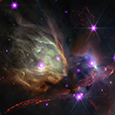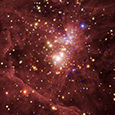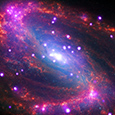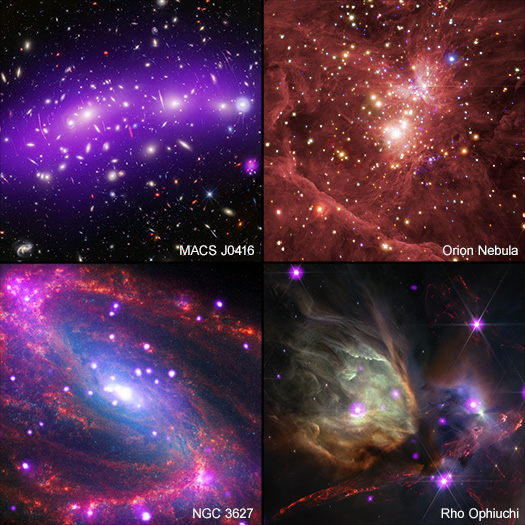Take a Summer Road Trip Through Images with NASA's Chandra, Webb
It’s time to take a cosmic road trip using light as the highway and visit four stunning destinations across space. The vehicles for this space get-away are NASA’s Chandra X-ray Observatory and James Webb Space Telescope.
In each of the images, which add Chandra data to previously released Webb images, the colors represent different wavelengths of X-ray, optical, or infrared light.
 The first stop on this tour is the closest, Rho Ophiuchi, at a distance of about 390 light-years from Earth. Rho Ophiuchi is a cloud complex filled with gas and stars of different sizes and ages. Being one of the closest star-forming regions, Rho Ophiuchi is a great place for astronomers to study young stars. In this image, X-rays from Chandra are purple and reveal the hot, outer atmospheres of infant stars. Infrared data from Webb is red, yellow, cyan, light blue, and darker blue and provides views of the spectacular regions of gas and dust.
The first stop on this tour is the closest, Rho Ophiuchi, at a distance of about 390 light-years from Earth. Rho Ophiuchi is a cloud complex filled with gas and stars of different sizes and ages. Being one of the closest star-forming regions, Rho Ophiuchi is a great place for astronomers to study young stars. In this image, X-rays from Chandra are purple and reveal the hot, outer atmospheres of infant stars. Infrared data from Webb is red, yellow, cyan, light blue, and darker blue and provides views of the spectacular regions of gas and dust.
 The next destination is the Orion Nebula, a giant cloud where stars are forming. Still located in the Milky Way galaxy, this region is a little bit farther from our home planet at about 1,500 light-years away. If you look just below the middle of the three stars that make up the “belt” in the constellation of Orion, you may be able to see this nebula through a small telescope. With Chandra and Webb, however, we get to see so much more. Chandra reveals young stars that glow brightly in X-rays, colored in red, green, and blue, while Webb shows the gas and dust in darker red that will help build the next generation of stars here.
The next destination is the Orion Nebula, a giant cloud where stars are forming. Still located in the Milky Way galaxy, this region is a little bit farther from our home planet at about 1,500 light-years away. If you look just below the middle of the three stars that make up the “belt” in the constellation of Orion, you may be able to see this nebula through a small telescope. With Chandra and Webb, however, we get to see so much more. Chandra reveals young stars that glow brightly in X-rays, colored in red, green, and blue, while Webb shows the gas and dust in darker red that will help build the next generation of stars here.
 It's time to leave our galaxy and visit another at a much greater distance of some 36 million light-years away. Like the Milky Way, NGC 3627 is a spiral galaxy that we see at a slight angle. NGC 3627 is known as a “barred” spiral galaxy because of the rectangular shape of its central region. From our vantage point, we can also see two distinct spiral arms that appear as arcs. X-rays from Chandra in purple show evidence for a supermassive black hole in its center as well as other dense objects like neutron stars and black holes pulling in matter. Meanwhile Webb finds the dust, gas, and stars throughout the galaxy in red, green, and blue. This image also contains optical data from NASA’s Hubble Space Telescope in red, green, and blue.
It's time to leave our galaxy and visit another at a much greater distance of some 36 million light-years away. Like the Milky Way, NGC 3627 is a spiral galaxy that we see at a slight angle. NGC 3627 is known as a “barred” spiral galaxy because of the rectangular shape of its central region. From our vantage point, we can also see two distinct spiral arms that appear as arcs. X-rays from Chandra in purple show evidence for a supermassive black hole in its center as well as other dense objects like neutron stars and black holes pulling in matter. Meanwhile Webb finds the dust, gas, and stars throughout the galaxy in red, green, and blue. This image also contains optical data from NASA’s Hubble Space Telescope in red, green, and blue.
 Our final landing place on this trip is the biggest and the farthest at a distance of about 4.3 billion light-years from Earth. MACS J0416 is a galaxy cluster, which are the largest objects in the universe held together by gravity. Galaxy clusters like this can contain hundreds or even thousands of individual galaxies all immersed in massive amounts of superheated gas that Chandra can detect. In this view, Chandra’s X-rays in purple show this reservoir of hot gas while Hubble and Webb pick up the individual galaxies in red, green, and blue. The long thin lines are caused by matter in the cluster distorting the light from galaxies behind MACS J0416 in a process known as gravitational lensing.
Our final landing place on this trip is the biggest and the farthest at a distance of about 4.3 billion light-years from Earth. MACS J0416 is a galaxy cluster, which are the largest objects in the universe held together by gravity. Galaxy clusters like this can contain hundreds or even thousands of individual galaxies all immersed in massive amounts of superheated gas that Chandra can detect. In this view, Chandra’s X-rays in purple show this reservoir of hot gas while Hubble and Webb pick up the individual galaxies in red, green, and blue. The long thin lines are caused by matter in the cluster distorting the light from galaxies behind MACS J0416 in a process known as gravitational lensing.
NASA's Marshall Space Flight Center manages the Chandra program. The Smithsonian Astrophysical Observatory's Chandra X-ray Center controls science from Cambridge Massachusetts and flight operations from Burlington, Massachusetts.

